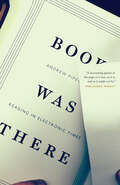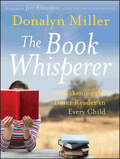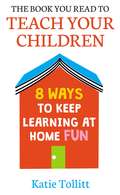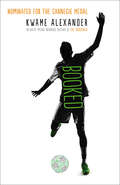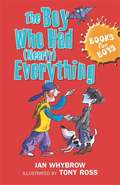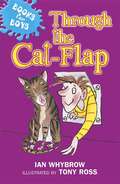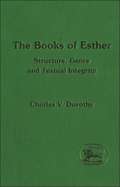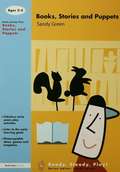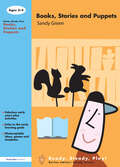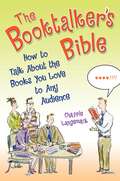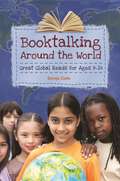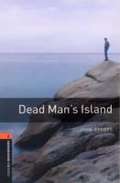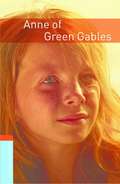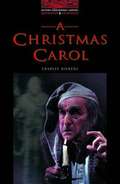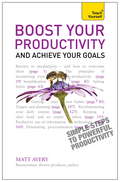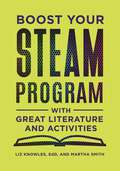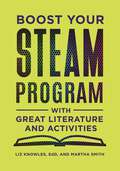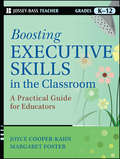- Table View
- List View
Book Was There: Reading in Electronic Times
by Andrew PiperAndrew Piper grew up liking books and loving computers. While occasionally burying his nose in books, he was going to computer camp, programming his Radio Shack TRS-80, and playing Pong. His eventual love of reading made him a historian of the book and a connoisseur of print, but as a card-carrying member of the first digital generation—and the father of two digital natives—he understands that we live in electronic times. Book Was There is Piper’s surprising and always entertaining essay on reading in an e-reader world. Much ink has been spilled lamenting or championing the decline of printed books, but Piper shows that the rich history of reading itself offers unexpected clues to what lies in store for books, print or digital. From medieval manuscript books to today’s playable media and interactive urban fictions, Piper explores the manifold ways that physical media have shaped how we read, while also observing his own children as they face the struggles and triumphs of learning to read. In doing so, he uncovers the intimate connections we develop with our reading materials—how we hold them, look at them, share them, play with them, and even where we read them—and shows how reading is interwoven with our experiences in life. Piper reveals that reading’s many identities, past and present, on page and on screen, are the key to helping us understand the kind of reading we care about and how new technologies will—and will not—change old habits. Contending that our experience of reading belies naive generalizations about the future of books, Book Was There is an elegantly argued and thoroughly up-to-date tribute to the endurance of books in our ever-evolving digital world.
Book Was There: Reading in Electronic Times
by Andrew PiperAndrew Piper grew up liking books and loving computers. While occasionally burying his nose in books, he was going to computer camp, programming his Radio Shack TRS-80, and playing Pong. His eventual love of reading made him a historian of the book and a connoisseur of print, but as a card-carrying member of the first digital generation—and the father of two digital natives—he understands that we live in electronic times. Book Was There is Piper’s surprising and always entertaining essay on reading in an e-reader world. Much ink has been spilled lamenting or championing the decline of printed books, but Piper shows that the rich history of reading itself offers unexpected clues to what lies in store for books, print or digital. From medieval manuscript books to today’s playable media and interactive urban fictions, Piper explores the manifold ways that physical media have shaped how we read, while also observing his own children as they face the struggles and triumphs of learning to read. In doing so, he uncovers the intimate connections we develop with our reading materials—how we hold them, look at them, share them, play with them, and even where we read them—and shows how reading is interwoven with our experiences in life. Piper reveals that reading’s many identities, past and present, on page and on screen, are the key to helping us understand the kind of reading we care about and how new technologies will—and will not—change old habits. Contending that our experience of reading belies naive generalizations about the future of books, Book Was There is an elegantly argued and thoroughly up-to-date tribute to the endurance of books in our ever-evolving digital world.
Book Was There: Reading in Electronic Times
by Andrew PiperAndrew Piper grew up liking books and loving computers. While occasionally burying his nose in books, he was going to computer camp, programming his Radio Shack TRS-80, and playing Pong. His eventual love of reading made him a historian of the book and a connoisseur of print, but as a card-carrying member of the first digital generation—and the father of two digital natives—he understands that we live in electronic times. Book Was There is Piper’s surprising and always entertaining essay on reading in an e-reader world. Much ink has been spilled lamenting or championing the decline of printed books, but Piper shows that the rich history of reading itself offers unexpected clues to what lies in store for books, print or digital. From medieval manuscript books to today’s playable media and interactive urban fictions, Piper explores the manifold ways that physical media have shaped how we read, while also observing his own children as they face the struggles and triumphs of learning to read. In doing so, he uncovers the intimate connections we develop with our reading materials—how we hold them, look at them, share them, play with them, and even where we read them—and shows how reading is interwoven with our experiences in life. Piper reveals that reading’s many identities, past and present, on page and on screen, are the key to helping us understand the kind of reading we care about and how new technologies will—and will not—change old habits. Contending that our experience of reading belies naive generalizations about the future of books, Book Was There is an elegantly argued and thoroughly up-to-date tribute to the endurance of books in our ever-evolving digital world.
Book Was There: Reading in Electronic Times
by Andrew PiperAndrew Piper grew up liking books and loving computers. While occasionally burying his nose in books, he was going to computer camp, programming his Radio Shack TRS-80, and playing Pong. His eventual love of reading made him a historian of the book and a connoisseur of print, but as a card-carrying member of the first digital generation—and the father of two digital natives—he understands that we live in electronic times. Book Was There is Piper’s surprising and always entertaining essay on reading in an e-reader world. Much ink has been spilled lamenting or championing the decline of printed books, but Piper shows that the rich history of reading itself offers unexpected clues to what lies in store for books, print or digital. From medieval manuscript books to today’s playable media and interactive urban fictions, Piper explores the manifold ways that physical media have shaped how we read, while also observing his own children as they face the struggles and triumphs of learning to read. In doing so, he uncovers the intimate connections we develop with our reading materials—how we hold them, look at them, share them, play with them, and even where we read them—and shows how reading is interwoven with our experiences in life. Piper reveals that reading’s many identities, past and present, on page and on screen, are the key to helping us understand the kind of reading we care about and how new technologies will—and will not—change old habits. Contending that our experience of reading belies naive generalizations about the future of books, Book Was There is an elegantly argued and thoroughly up-to-date tribute to the endurance of books in our ever-evolving digital world.
Book Was There: Reading in Electronic Times
by Andrew PiperAndrew Piper grew up liking books and loving computers. While occasionally burying his nose in books, he was going to computer camp, programming his Radio Shack TRS-80, and playing Pong. His eventual love of reading made him a historian of the book and a connoisseur of print, but as a card-carrying member of the first digital generation—and the father of two digital natives—he understands that we live in electronic times. Book Was There is Piper’s surprising and always entertaining essay on reading in an e-reader world. Much ink has been spilled lamenting or championing the decline of printed books, but Piper shows that the rich history of reading itself offers unexpected clues to what lies in store for books, print or digital. From medieval manuscript books to today’s playable media and interactive urban fictions, Piper explores the manifold ways that physical media have shaped how we read, while also observing his own children as they face the struggles and triumphs of learning to read. In doing so, he uncovers the intimate connections we develop with our reading materials—how we hold them, look at them, share them, play with them, and even where we read them—and shows how reading is interwoven with our experiences in life. Piper reveals that reading’s many identities, past and present, on page and on screen, are the key to helping us understand the kind of reading we care about and how new technologies will—and will not—change old habits. Contending that our experience of reading belies naive generalizations about the future of books, Book Was There is an elegantly argued and thoroughly up-to-date tribute to the endurance of books in our ever-evolving digital world.
Book Was There: Reading in Electronic Times
by Andrew PiperAndrew Piper grew up liking books and loving computers. While occasionally burying his nose in books, he was going to computer camp, programming his Radio Shack TRS-80, and playing Pong. His eventual love of reading made him a historian of the book and a connoisseur of print, but as a card-carrying member of the first digital generation—and the father of two digital natives—he understands that we live in electronic times. Book Was There is Piper’s surprising and always entertaining essay on reading in an e-reader world. Much ink has been spilled lamenting or championing the decline of printed books, but Piper shows that the rich history of reading itself offers unexpected clues to what lies in store for books, print or digital. From medieval manuscript books to today’s playable media and interactive urban fictions, Piper explores the manifold ways that physical media have shaped how we read, while also observing his own children as they face the struggles and triumphs of learning to read. In doing so, he uncovers the intimate connections we develop with our reading materials—how we hold them, look at them, share them, play with them, and even where we read them—and shows how reading is interwoven with our experiences in life. Piper reveals that reading’s many identities, past and present, on page and on screen, are the key to helping us understand the kind of reading we care about and how new technologies will—and will not—change old habits. Contending that our experience of reading belies naive generalizations about the future of books, Book Was There is an elegantly argued and thoroughly up-to-date tribute to the endurance of books in our ever-evolving digital world.
The Book Whisperer: Awakening the Inner Reader in Every Child
by Donalyn MillerDonalyn Miller says she has yet to meet a child she couldn't turn into a reader. No matter how far behind Miller's students might be when they reach her 6th grade classroom, they end up reading an average of 40 to 50 books a year. Miller's unconventional approach dispenses with drills and worksheets that make reading a chore. Instead, she helps students navigate the world of literature and gives them time to read books they pick out themselves. Her love of books and teaching is both infectious and inspiring. The book includes a dynamite list of recommended "kid lit" that helps parents and teachers find the books that students really like to read.
The Book Whisperer: Awakening the Inner Reader in Every Child
by Donalyn MillerDonalyn Miller says she has yet to meet a child she couldn't turn into a reader. No matter how far behind Miller's students might be when they reach her 6th grade classroom, they end up reading an average of 40 to 50 books a year. Miller's unconventional approach dispenses with drills and worksheets that make reading a chore. Instead, she helps students navigate the world of literature and gives them time to read books they pick out themselves. Her love of books and teaching is both infectious and inspiring. The book includes a dynamite list of recommended "kid lit" that helps parents and teachers find the books that students really like to read.
The Book You Read to Teach Your Children: 8 Ways to Keep Learning at Home Fun
by Katie Tollitt"I can't get them to concentrate without bribes!""We lasted ten minutes and now she's refusing to do anything." "Frozen 2 counts as English and Science, right?"If this sounds like your experience of teaching at home, then this book is for you. Primary school teacher and education influencer Katie Tollitt is here to help you revolutionise your relationship with teaching your primary school children at home. Covering eight key principles for how to approach learning in ways that maximise fun, and minimise stress, this short accessible book emphasises the need for flexibility, conversation and openness.
Booked (The Crossover Series)
by Kwame AlexanderLike lightning/you strike/fast and free/legs zoom/down field/eyes fixed/on the checkered ball/on the goal/ten yards to go/can’t nobody stop you/can’t nobody cop you…Twelve-year-old Nick is a football-mad boy who absolutely hates books. In this follow-up to the Newbery-winning novel The Crossover, football, family, love, and friendship take centre stage as Nick tries to figure out how to navigate his parents’ break-up, stand up to bullies, and impress the girl of his dreams. These challenges – which seem even harder than scoring a tie-breaking, game-winning goal – change his life, as well as his best friend’s. This energetic novel-in-verse by the poet Kwame Alexander captures all the thrills and setbacks, the action and emotion of a World Cup match.
Books For Boys, Book 6: The Boy Who Had (Nearly) Everything (PDF)
by Ian WhybrowImagine what it's like getting everything you want. That's how it is for Lucky Fries O'Mighty - until his seventh birthday. How can Billy Humble show Fries what his life is missing? With imaginaton, and his amazing dog, Whizz the Fleabag, that's how!
Books For Boys, Book 8: Through the Cat-Flap (PDF)
by Ian WhybrowThomas can't work out what goes on in the tiny minds of his toddler twin sisters. They sing all the time but never get the words right. They think cats enjoy being dressed up as fairies. But who else can Thomas turn to when they all get locked out of the house? Besides, it's a brilliant idea to pop them through the cat-flap and tell them to look for the keys. Isn't it ...?
The Books of Esther: Structure, Genre and Textual Integrity (The Library of Hebrew Bible/Old Testament Studies)
by Charles V. DorothyThe Books of Esther applies form-critical tools to the Septuagint and non-Septuagint ('Lucianic') Greek texts of Esther. Differences in vocabulary, content and style show that the Greek books of Esther are independent traditions stemming from, and aimed at, two distinct religious communities. The 'Lucianic' version appears more personal, orthodox, nationalistic and Jewish; its audience is Palestinian and it intends to foster communal identity. The Septuagint version breathes a more matter-of-fact, reportorial, Hellenistic style, with an eye to tolerance of heretics and audience entertainment. The Masoretic version became canonized because it is the most multivalent of the Esthers, appealing to both religious and secular elements of Judaism.
Books, Stories and Puppets (Ready, Steady, Play!)
by Green SandyPart of the Ready, Steady, Play! series, Books, Stories and Puppets promotes visual storytelling and provides ideas for extending learning through a range of stories and characters that are well-known and much loved by children and adults alike. This book: provides ideas and templates for visual resources that will enhance storytime outlines fun ideas across all curriculum areas, linked to favourite stories encourages the use of drama as a mode of story telling. Containing simple but excellent ideas for creative play experiences for all early years practitioners and students on early years courses, this book is also recommended reading for parents looking for inspiration.
Books, Stories and Puppets (Ready, Steady, Play!)
by Green SandyPart of the Ready, Steady, Play! series, Books, Stories and Puppets promotes visual storytelling and provides ideas for extending learning through a range of stories and characters that are well-known and much loved by children and adults alike. This book: provides ideas and templates for visual resources that will enhance storytime outlines fun ideas across all curriculum areas, linked to favourite stories encourages the use of drama as a mode of story telling. Containing simple but excellent ideas for creative play experiences for all early years practitioners and students on early years courses, this book is also recommended reading for parents looking for inspiration.
The Booktalker's Bible: How to Talk About the Books You Love to Any Audience
by Chapple LangemackWhether you're preparing for your first booktalk or you're a seasoned booktalking pro, this lively and light-hearted guide provides all the information you need to create a smashing booktalking program—from finding your audience and choosing the books to performing the booktalk and evaluating the program. Filled with insightful, humorous, and inspiring stories from some of today's best booktalkers, this practical guide includes hundreds of sample booktalks, reproducible forms, and booktalk booklists for a wide variety of audiences. A must purchase for anyone who booktalks or wants to get started.Topics include:• Why Booktalk?• The Golden Rules of Booktalking• Choosing Your Books• Building a No-Fail Booktalk• Delivering a Dazzling Booktalk• Booktalking to Adults• Booktalking to Children and Teens• Booktalking in Schools• Taking It on the Road• Booktalking Variations• Evaluation and All That Jazz
Booktalking Around the World: Great Global Reads for Ages 9–14
by Sonja ColeThis text contains convenient, ready-to-go booktalks for contemporary fiction and nonfiction books set in every continent around the globe, useful for librarians and other educators of grades three through nine.A public librarian introducing young readers to stories from around the world. A social studies teacher wanting to offer students extra credit on a unit about ancient Greece. A Spanish teacher who needs to generate some excitement and interest about Hispanic culture. All of these educators can achieve their goals by utilizing the internationally themed booktalk suggestions in this text—Booktalking Around the World: Great Global Reads for Ages 9–14.This collection of booktalks and book lists is designed to be an invaluable resource for teachers as well as school and public librarians seeking geographically themed booktalks for newer books published from 2000–2010. Because studying the countries of the world is a major part of most school curricula, this book will support or extend this important curricular area. All the booktalks in this collection are aimed at children aged 9–14. All seven continents are represented, but the United States is excluded.
Bookworms, Stage 2: Dead Man's Island
by John EscottThe Oxford Bookworms Library offers enjoyable reading at seven levels (Starter to Stage 6). To find your required reading level please take the Oxford Bookworks reading level test. Mr Ross lives on an island where no visitors come. He stops people from taking photographs of him. He is young and rich, but he looks sad. And there is one room in his house which is always locked. Carol Sanders and her mother come to the island to work for Mr Ross. Carol soon decides that there is something very strange about Mr Ross. Where did he get his money from? How can a young man buy an island? So she watches, and she listens - and one night she learns what is behind the locked door.
Bookworms, Stage 2: Anne of Green Gables
by Clare Montgomery WestThe Oxford Bookworms Library offers enjoyable reading at seven levels (Starter to Stage 6). To find your required reading level please take the Oxford Bookworks reading level test. Marilla Cuthbert and her brother Matthew want to adopt an orphan, to help on the farm at Green Gables. They ask for a boy, but they get Anne, who has red hair and freckles, and who talks and talks and talks. They didn't want a girl, but how can they send a child back, like an unwanted parcel? So Anne stays, and begins a new life in the sleepy, quiet village of Avonlea in Canada. But it is not so quiet after Anne comes to live there...
Bookworms, Stage 2: Anne of Green Gables
by Clare Montgomery WestThe Oxford Bookworms Library offers enjoyable reading at seven levels (Starter to Stage 6). To find your required reading level please take the Oxford Bookworks reading level test. Marilla Cuthbert and her brother Matthew want to adopt an orphan, to help on the farm at Green Gables. They ask for a boy, but they get Anne, who has red hair and freckles, and who talks and talks and talks. They didn't want a girl, but how can they send a child back, like an unwanted parcel? So Anne stays, and begins a new life in the sleepy, quiet village of Avonlea in Canada. But it is not so quiet after Anne comes to live there...
Bookworms, Stage 3: A Christmas Carol (PDF)
by Clare West Charles DickensThe Oxford Bookworms Library offers enjoyable reading at seven levels (Starter to Stage 6). To find your required reading level please take the Oxford Bookworks reading level test. Ebeneezer Scrooge is a cross, miserable, mean old man. When his nephew visits him on Christmas Eve to wish him a merry Christmas, Scrooge is not at all pleased. Bah! Humbug! he says. Christmas is humbug! Everyone who goes around saying 'Merry Christmas' should have his tongue cut out. Yes, he should! Oh yes, Scrooge is a hard, mean man. His clerk, Bob Cratchit, gets only fifteen shillings a week, and has to work in a cold little office, with a fire too small to warm even his toes. But that Christmas Eve Scrooge is visited by the ghost of his long-dead partner, Jacob Marley. And after him come three more ghostly visitors ... It is a long night, and a frightening night, and when Christmas Day finally arrives, Scrooge is a very different man indeed.
Boost Your Productivity and Achieve Your Goals: Teach Yourself Ebook (Teach Yourself)
by Matt AveryWe all have things we want to achieve, goals we want to reach, targets we want to hit. But how often do we find ourselves saying, 'If only there were more hours in the day' or simply 'I don't have time'? Time Management, however, is dead. Productivity - getting more done in the time we have - is king. However productive you already are, you will find this book full of practical tips on how to achieve more in less time.In the past few years alone the author, Matt Avery, has been running three businesses concurrently, as well as writing five books, and producing two musicals for the Edinburgh fringe. He is 'Mr Productivity' and in this book he shares his secrets.
Boost Your STEAM Program with Great Literature and Activities
by Liz Knowles Martha SmithYou've created a STEAM program in your library, but how do you work literacy into the curriculum? With this collection of resource recommendations, direction for program development, and activities, you'll have students reading proficiently in no time.Many schools and libraries are implementing STEAM programs in the school library makerspace to promote problem solving by allowing students to create their own solutions to a problem through trial and error. In order to enhance literacy development in the STEAM program, however, they need resources for integrating literature into the curriculum. In this collection of resources for doing just that, veteran education professionals and practiced coauthors Liz Knowles and Martha Smith bring readers over eight hundred recommended and annotated books and web resources, selected based on research on successfully integrating STEAM and literacy programs and organized by the five STEAM areas. Titles are complemented by discussion questions and problem-solving activities that will aid educators in both adding and using the best literature to their STEAM programs for encouraging learning. In addition to promoting literacy, these resources will help to develop creativity, lateral thinking skills, and confidence in students.
Boost Your STEAM Program with Great Literature and Activities
by Liz Knowles Martha SmithYou've created a STEAM program in your library, but how do you work literacy into the curriculum? With this collection of resource recommendations, direction for program development, and activities, you'll have students reading proficiently in no time.Many schools and libraries are implementing STEAM programs in the school library makerspace to promote problem solving by allowing students to create their own solutions to a problem through trial and error. In order to enhance literacy development in the STEAM program, however, they need resources for integrating literature into the curriculum. In this collection of resources for doing just that, veteran education professionals and practiced coauthors Liz Knowles and Martha Smith bring readers over eight hundred recommended and annotated books and web resources, selected based on research on successfully integrating STEAM and literacy programs and organized by the five STEAM areas. Titles are complemented by discussion questions and problem-solving activities that will aid educators in both adding and using the best literature to their STEAM programs for encouraging learning. In addition to promoting literacy, these resources will help to develop creativity, lateral thinking skills, and confidence in students.
Boosting Executive Skills in the Classroom: A Practical Guide for Educators
by Joyce Cooper-Kahn Margaret FosterA guide for helping students with weak Executive Function skills to learn efficiently and effectively Students with weak Executive Function skills need strong support and specific strategies to help them learn in an efficient manner, demonstrate what they know, and manage the daily demands of school. This book shows teachers how to do exactly that, while also managing the ebb and flow of their broader classroom needs. From the author of the bestselling parenting book Late, Lost, and Unprepared, comes a compilation of the most practical tools and strategies, designed to be equally useful for children with EF problems as well as all other students in the general education classroom. Rooted in solid research and classroom-tested experience, the book is organized to help teachers negotiate the very fluid challenges they face every day; educators will find strategies that improve their classroom "flow" and reduce the stress of struggling to teach students with EF weaknesses. Includes proven strategies for teachers who must address the needs of students with Executive Function deficits Contains information from noted experts Joyce Cooper-Kahn, a child psychologist and Margaret Foster, an educator and learning specialist Offers ways to extend learning and support strategies beyond the classroom The book's reproducible forms and handouts are available for free download This important book offers teachers specific strategies to help students with EF deficits learn in an efficient manner, demonstrate what they know, and manage the daily demands of school.
